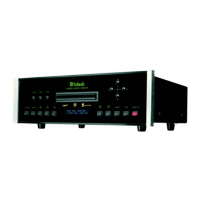MS300 Advanced Users Guide
3/3/2005
Page 13 of 65
2 Chambers Street • Binghamton, NY 13903-269 Phone: 607-723-3512 / 800-538-6576 • Fax: 607-724-0549
Technical Support 866-458-6910 9:00AM to 6:00PM EST, M-F www.mcintoshlabs.com
MS300 Networking: Beyond Ethernet
The MS300 contains built-in Ethernet networking and optional external dialup modem
support. In addition to these types of network connections, you may want to integrate the
MS300 into other networks such as 802.11 Wireless (WiFi), Powerline, or HomePNA
(HPNA).
Although there are dozens of brands on the market, McIntosh recommends and supports
D-Link
and Linksys home networking products because of their wide availability and
installed base within our market. The Linksys web site
is an excellent source for
information on building home networks.
Wireless Networking
Wireless Networking, commonly referred to as “WiFi” or 802.11a/b/g, is defined as a
local area network that uses 2.4GHz radio signals to transmit and receive data over
distances of a few hundred feet using the ethernet protocol.
The MS300 can be added to a wireless home network using an external Ethernet to
Wireless adapter such as the Linksys Wireless Ethernet Bridges. The Ethernet Bridge will
“bridge” the gap between the MS300’s Ethernet port and the home network’s wireless
access point. When used with a broadband Internet connection, this networking
configuration effectively converts the MS300’s wired Ethernet signals to travel wirelessly
to the home network’s wireless access point, then onto the Internet.
MS300 Connected to a Wireless Network
Be sure to use an adapter which supports the version of 802.11 (A, B, or G) that the
user’s Wireless Access Point supports. Refer to the Access Point’s documentation for
more information.

